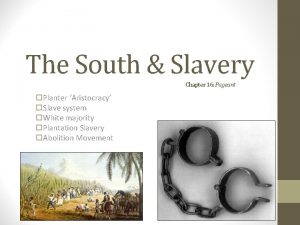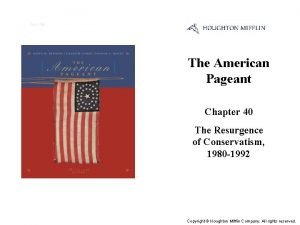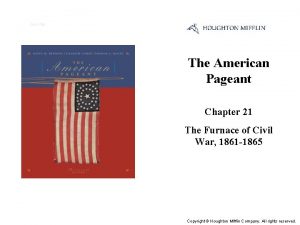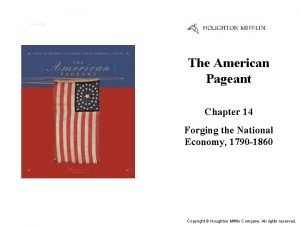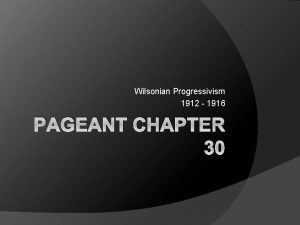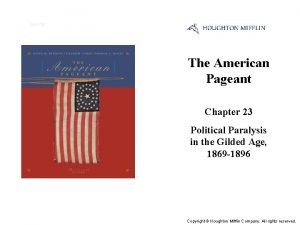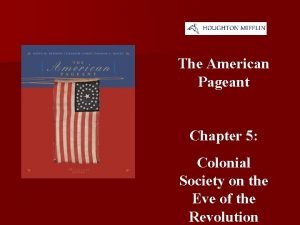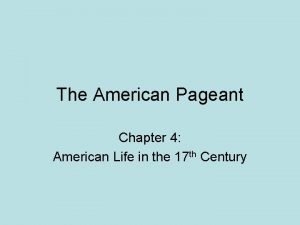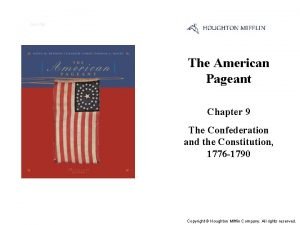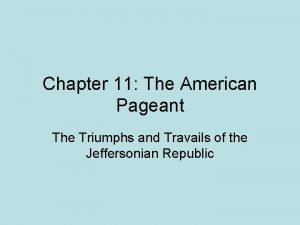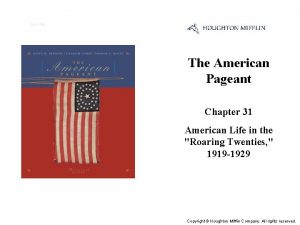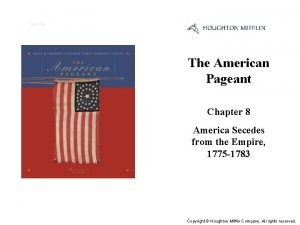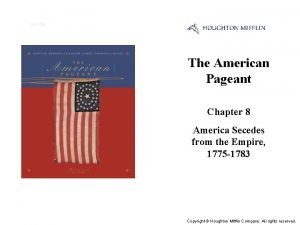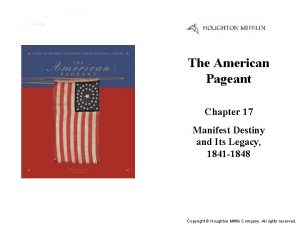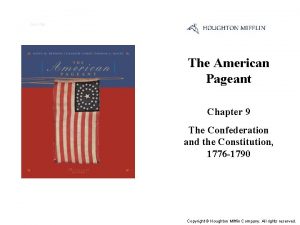Cover Slide The American Pageant Chapter 4 American












- Slides: 12

Cover Slide The American Pageant Chapter 4 American Life in the Seventeenth Century, 1607 -1692 Copyright © Houghton Mifflin Company. All rights reserved.

A Festival, painted by a German visitor to Georgia A German visitor to Georgia painted this watercolor of a Yuchi ceremony, which he titled A Festival. The guns hanging inside the shelter were probably acquired from English traders in South Carolina. (Royal Library Copenhagen) Copyright © Houghton Mifflin Company. All rights reserved.

African slavery, inland trade Slavery was widespread in Africa long before Portuguese traders started landing along the continent's western coastline. For centuries African slaves were primarily debtors, criminals, or captives of wars, and slavery was often a temporary condition. Once Europeans came, slaves were permanently removed from Africa, and almost always for lifelong slavery. Europeans who landed at the Gold Coast, or what became known as the "Slave Coast, " reached farther and farther into the interior to take larger numbers of Africans into bondage. (Paris, Bibliothèque Nationale de France, photo © B. n. F. ) Copyright © Houghton Mifflin Company. All rights reserved.

An East Prospect of the City of Philadelphia, 1756 The converging streams flowing into the Delaware River in the map constitute the Dock. The engraving at the top illustrates Philadelphia's dynamism as a port city at the time of the Seven Years War. (Library of Congress) Copyright © Houghton Mifflin Company. All rights reserved.

Baltimore in 1752, from a sketch by John Moale, Esq. Baltimore was founded in 1629 and served as a shipping center for Maryland tobacco growers. By 1752, when this view was drawn, it had begun to show signs of developing into a prosperous port city. After the American Revolution, Baltimore expanded and by the 1790 s boasted a population of over twenty thousand. (Maryland Historical Society, Baltimore) Copyright © Houghton Mifflin Company. All rights reserved.

Interior of the Old Ship Meeting House in Hingham, Massachusetts The meetinghouse, or church, stood at the center of every Puritan community in colonial New England. Built in 1681, the Old Ship Meeting House of Hingham, Massachusetts, was designed to resemble the hull of an upside down ship. Although the Hingham church is simple and unadorned, the placement of the pews and their assignment to local families based on their wealth, background, and social standing, makes clear that the Puritans were not radical egalitarians like the Quakers. (Peter Vanderwarker ) Copyright © Houghton Mifflin Company. All rights reserved.

Slave ship This plan graphically depicts the crowded, unsanitary conditions under which enslaved Africans were packed like cargo and transported across the Atlantic. (Library of Congress) Copyright © Houghton Mifflin Company. All rights reserved.

Southeast Prospect of the City of Philadelphia by Peter Cooper Founded just four decades earlier, Philadelphia was already one of British America's largest and wealthiest cities. (Library Company of Philadelphia) Copyright © Houghton Mifflin Company. All rights reserved.

The Quaker Meeting by Egbert Van Heemskerk This sketch of a Quaker meeting highlights one of the most radical of Quaker practices: allowing women to speak in church. Most Protestant denominations, because of their reading of Saint Paul, enforced the rule of silence on women. But Quakers struck a blow at seventeenth-century gender notions by granting women an active ministerial role, a voice in church policy, and decision-making responsibilities on issues relating to the church and the family. (The Quaker Collection, Haverford College Library) Copyright © Houghton Mifflin Company. All rights reserved.

Tobacco plantation While a planter smokes a pipe and confers with his overseer, slaves on this Chesapeake plantation perform all of the tasks related to planting, cultivating, harvesting, sorting, packaging, and delivering the profitable tobacco. Slaves also fashioned the tools for coopering and made barrels for transporting hogsheads of "the weed. " Ships in the background navigate right up to the edge of the plantation lands. (Library of Congress) Copyright © Houghton Mifflin Company. All rights reserved.

Tobacco trade card, Philadelphia, 1770 This trade card (advertisement) issued by a Philadelphia tobacco dealer in 1770 shows a convivial group of wealthy men at a tavern. The leisurely activity depicted here and the advertisement itself were signs of the new rituals of consumption. Merchants began to advertise only when their customers could choose among different ways of spending money. (Library Company of Philadelphia) Copyright © Houghton Mifflin Company. All rights reserved.

Map: African Origins of North American Slaves, 1690 -1807 Virtually all slaves brought to English North America came from West Africa, between Senegambia and Angola. Most were captured or bought inland marched to the coast, where they were sold to African American merchants who in turn sold them to European slave traders. Copyright © Houghton Mifflin Company. All rights reserved.
 American pageant chapter 16
American pageant chapter 16 Chapter 35 american pageant
Chapter 35 american pageant Chapter 40 american pageant
Chapter 40 american pageant Chapter 21 the american pageant
Chapter 21 the american pageant American pageant chapter 14
American pageant chapter 14 American pageant chapter 13
American pageant chapter 13 American pageant chapter 30
American pageant chapter 30 Chapter 23 american pageant
Chapter 23 american pageant American pageant chapter 34
American pageant chapter 34 Chapter 5 american pageant
Chapter 5 american pageant Chapter 4 the american pageant
Chapter 4 the american pageant The american pageant chapter 9
The american pageant chapter 9 American pageant chapter 11
American pageant chapter 11
